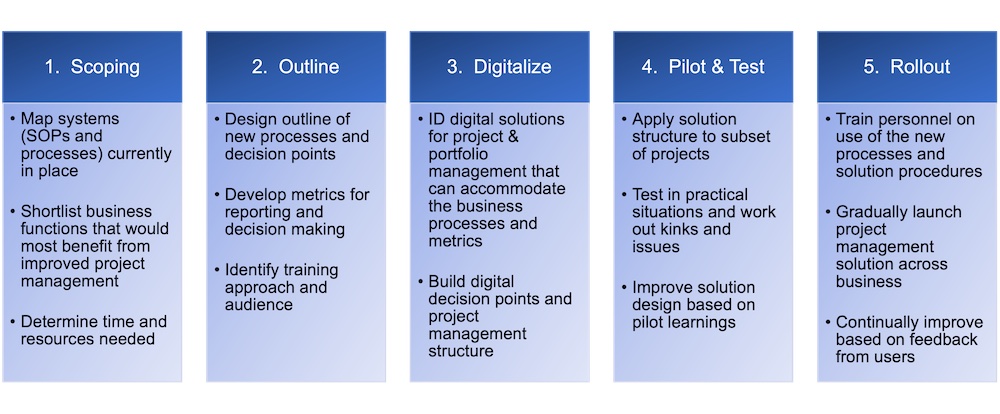
- Digital project and portfolio management tools and methods offer much easier and faster collaboration and information sharing in project teams.
- We outline how any organization can transition from old tools such as Excel and PowerPoint by designing metrics, training project teams, and setting up modern digital tools.
Effective project management is essential to run a business well. There are advanced digital tools available that help make project management more efficient and collaborative. However, many organizations still rely on old tools such as Excel sheets and PowerPoint slides. The newer digital tools are measurably better, both for ease of collaboration and for information sharing. But how can an organization make the transition away from Excel?
The benefits of improved project portfolio management (PPM) are well known. First, projects can be completed on time and within budget. This is the main purpose of project plans and timelines. They allow for faster and more efficient launches of new products and services. Capital projects and other operational activities can be completed faster. For new product and service launches, detailed project planning accelerates new sales, which directly grows the bottom line. This should be a slam dunk.
Another benefit is that resources, both people and capital, are used more efficiently. Downtime is reduced with better planning. However, there are challenges and risks. Line and senior management must be on board. They must be seen by the organization as actively supporting the new processes and systems that will be put in place. Even with management support, there might be significant organizational resistance to overcome. Experienced professionals may be unwilling to take the time and effort to learn new ways of working. To persuade this group, the benefits of project management must always be clearly visible throughout the implementation. This requires careful measurement of business impacts and results.
In my experience, setting up a new system is most successful if the following steps are followed (see chart). It will take some time to do a thorough rollout, but this is time gained from the backend. This is because fewer issues and challenges will be experienced by users with a thorough design. The new system will be effective sooner and it will be more widely adopted by the organization.

Set goals and metrics
It is tempting to set the goals of an organizational change project to achieving a small initial success, for example by using the PPM methods and processes on one project or one business unit only. If successful, this can persuade stakeholders that the change effort can succeed on a larger scale. The inevitable unexpected problems that arise can be solved on a small scale before the larger organization is impacted.
This approach has several disadvantages. We believe that an organization is well advised to go big from the start. The benefits of faster commercialization and more efficient resource usage are reached sooner on a much larger scale. The attention of the whole firm is focused on the change effort and it cannot be dismissed as a trial that affects one unit only.
A big organizational change project carries significant risks, from poor execution to inadequate IT resources and ineffective training programs. Most importantly, it needs ongoing support and training. The initial rollout should be carefully planned to anticipate and mitigate as many of these risks as possible. It’s vital to include learnings from similar projects in other organizations. A voluminous literature exists on implementing new project management functions, so if issues come up during the rollout, they will likely have solutions based on past experience.
The first metric that comes to mind for an organizational change effort is return on investment. What is the cost of the change effort, both in terms of employees’ time for training and of external resources (professional development courses, workshops, and consultants)? What can we quantify for benefits? This may be difficult, because it may not be obvious how much sales revenue is due to faster product or service launches.
However, there are other metrics. With faster launches, the number of projects in the pipeline should increase if the size of the workforce is the same. There will also be more and higher quality ideas and concepts in the early stage pipeline. And employees will be happier because their projects will be more successful and will encounter fewer issues with improved risk management. These outcomes can be measured quantitatively.
1. Scoping
The first stage after setting the rollout targets is scoping what project management methods and tools are currently in place. Some business functions may already be using digital project management systems. Others may rely on older tools. For example, there may be a spreadsheet or pivot table with a list of projects or a custom-built project database.
In many cases, such solutions are functional, but don’t allow effective collaboration on a project. Sharing files and commenting on others’ work requires a separate system such as Teams Chat or Slack. It is also often difficult to obtain project portfolio level insights and dashboards, because older systems are not set up for those purposes. Without those data reporting functions, it is near impossible to get accurate, real-time data for organizational metrics and scorecards.
Collaboration and real-time data dashboards are features of commercial PPM software applications. In the scoping phase, we will investigate the suitability of such systems. There is a range of commercial software applications available for this purpose. Each has strengths and weaknesses that make it good for one situation but perhaps less suited to a different one.
The outcome of the scoping phase will be a list of business functions that would most benefit from improved project management and data reporting. It will also include an overview of current tools, available external software and tools, and a proposal with the time and resources needed to build an improved process. The proposal will describe how the new process will improve the organizational metrics defined at the start of the project.
2. Outline
Building on the scoping results, in the outline phase we will build a detailed plan for the new PPM process. The needs of each business function will be taken into account. The project management needs will be different for different functions. For example, in manufacturing, tracking and approval processes for capital expenditures will be needed, whereas in innovation screening of early stage product concepts is important. As much as possible, commonalities between business functions and business units must be incorporated, to avoid fragmenting into non-standardized systems. In the long run, such custom systems will stop being mutually compatible, which will make comparing project values and risks very challenging.
The new PPM process will include custom metrics and dashboards for the business. Such metrics, which can include value and risk, resource usage, customer value provided, product launch dates, etc., will be updated in real time and visualized on dashboards. These dashboards are tailored according to the informational needs of each business function. The ability to offer custom dashboards on demand is one of the big benefits of digital PPM.
When a plan for each business need is formulated, a transition plan is set up. This plan includes solution design timing, data transfer and archiving, and training for current and future users of the process. Existing technical support staff is moved over to the new process for ongoing technical help, which will be needed because users are unfamiliar with the new system at first.
With training, more is better, especially for users who may use the PPM system only occasionally, or partly. It is a good idea to recruit power users who can train users locally and in person. This will improve organizational acceptance of the new process. It will also reduce the demand on technical support staff, both internally and at the digital solution provider.
3. Digitalize

To realize the main advantages of PPM, it must be set up as a digital platform using one of the software applications mentioned earlier. The type of PPM software to use depends on the kind of projects the organization runs and how data intensive they are. For a service-oriented organization, a ticket-based system may suffice. For companies conducting multi-year development programs that require major investments in time and resources, a stage-gate (or phase-gate) process is generally used. Such a process divides a project into stages with decision points at the end of each stage, called gates. At each gate, the managing team makes a decision on whether to continue the project (with additional resource investment) or stop.
The stage-gate approach is very suitable for digitalization. It can be run almost entirely remotely, with data stored in the cloud. There are many advantages to using a digital platform to run a stage-gate process. However, the digital system needs to be a clear time saver for project team members. In our experience, if a digital solution is too far away from current practice, it will not be used unless its use is mandated by management or offers users major benefits over the current solution.
During initial implementation of the digital PPM, existing project data needs to be imported from legacy software. This can be complex and time consuming. Projects that are already advanced will need to bypass the normal project approval process, which may cause software issues. Therefore, there will be a transition period while legacy projects move through the process. For smaller projects, this is not as big a challenge, because they are generally shorter in duration. Some organizations may run only small, relatively simple projects, for which data importing will be straightforward.
The roles and responsibilities of project team members should be clearly defined, because different team members may have different tasks and access rights in the digital platform. The project approvers and managers may be different for different business units and functional areas. For bigger projects, we recommend assigning a trained project manager. For small projects, the project leaders can be trained in the basics of PPM.
4. Pilot & Test
Before rolling out the digital PPM to the whole organization, it should be tested on a few representative pilot projects. Any kinks or issues in the system can be identified at this stage. Several scenarios may be run to observe how the PPM system reacts. The system should be operating flawlessly before rolling it out.
At this time, the training plan can also be piloted with key users. Does the training adequately address the needs of the target audience? After the initial training, ongoing training and support will be needed to keep the learnings fresh and to train new users.
5. Rollout
When the training program is in place and existing project data is populated in the new PPM system, the process is ready to go live. This should be done with some fanfare so that members of the organization who are not involved in running projects are aware of the PPM system. It should also be possible to start reporting up to date metrics at this time.
After rollout, ongoing technical support needs to be offered to users. This may be done by the software vendor or by external consultants. It’s highly useful to collect feedback from users so that the system can be improved continually.
Next steps
We have experience designing and implementing digital PPM systems in different organizations. Let’s set up an introductory 15-minute phone call to explore how your organization could benefit from the faster project launches and real-time data dashboards that come with digital PPM.
Measured Innovation is a consulting firm with over 20 years experience developing and launching products in the consumer goods and chemical industries.
